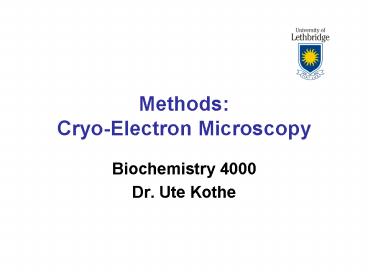Methods: Cryo-Electron Microscopy PowerPoint PPT Presentation
1 / 14
Title: Methods: Cryo-Electron Microscopy
1
MethodsCryo-Electron Microscopy
- Biochemistry 4000
- Dr. Ute Kothe
2
Why electrons?
Visible Light l 400 600 nm
Electrons l 0.002 0.004 nm Remember
wave-particle dualism de Broglie l h /
mv E ½ m v²
3
Electron Microscope (EM)
Light Microscope
Transmission Scanning Electron Microscope
4
Transmission Electron Microscope (TEM)
Electron source Thermal emission from heated
cathode Focussing Electro-magnetic
Lenses Detection Phosphor screen or CCD camera
(former times negative)
Vacuum!
5
Pro Con of EM
- Pro
- Short wavelength high resolution (in reality up
to 3A) - Strong interaction with materials good contrast
- Electromagnetic lenses works as standard optics
(in contrast to X-ray crystallography) - High intensity is easy to produce
- Also inner structure of biomolecule accessible
- Con
- High vaccuum requires special treatment of sample
- Sample has to be thin to avoid 100 absorption
- Low contrast of biomolecules
- Electron beam damages sample, i.e. only short
measurements possible
6
Sample Preparation - Staining
- To increase contrast heavy atoms intract
stronger with e- than biomolecules (C, N, O, S,
P) - Positive Staining
- treat sample with solution of salt like uranyl
acetate, lead citrate, osmium tetraoxide object
is black on light background - Negative Staining
- place sample on dried film of heavy metal salt
object is light spot on black background - Shadowing
- spray thin layer of heavy metal on sample to
produce a shadow - Disadvantage
- Size of stain reduces resolution to about 20-30 Å
7
Alternative Cryo-EM
- to avoid harsh staining which may change
- the structure of your sample
- stabilization of sample by rapid freezing of
- sample in liquid ethane to form vitreous ice
- into electron microscope at low
- temperatures to keep sample stable in
- hydrated state in vacuum
- thickness of ice layer as small as possible!
- Advantage
- sample structure unchanged
- inner structure of molecule is accessible
8
Types of Samples
- Periodic arrangement
- gt 2D electron crystallography
- small or membrane proteins lt 200 kDa
- resolution up to 2.5 Å
- Random arrangement
- gt single particle technique
- macromolecular complexes gt 200 kDa
- resolution 7 30 Å
- Large Organelles (Golgi, ER), whole cells
- gt tomography
- resolution gt 40 Å
Bacteriorhodopsin
Ribosome
9
Overview of steps
Challenge Processing of images to filter noise
from signal
10
Image Processing
Improve signal to noise by Overlaying many
pictures
Problem objects are arranged in different
orientations
11
Alignment Classification
Rough alignment of pictures (up to
100,000) Correspondence analysis groups images
using statistical methods Challenging process
requiring at least 5 parameters Images with same
orientation will be averaged (class averages)
Raw Images Class Averages
12
3D Reconstruction
When the angles between the different classes are
known (estimated), a 3D model can be calculated.
Iterative Process 3D model is used to generate
2D images which are fed into statistical analysis
of images (alignment and classification).
13
Final Model
Cube containing density distribution of
reconstructed complex
3D visualization define density cut-off between
molecule and environment Correlate size of
molecule with know molecular mass (density of
proteins 1.3 1.37 g/cm3)
14
And then?
Try to interpret 3D map, e.g. try to fit known
crystal structures into electron density map

